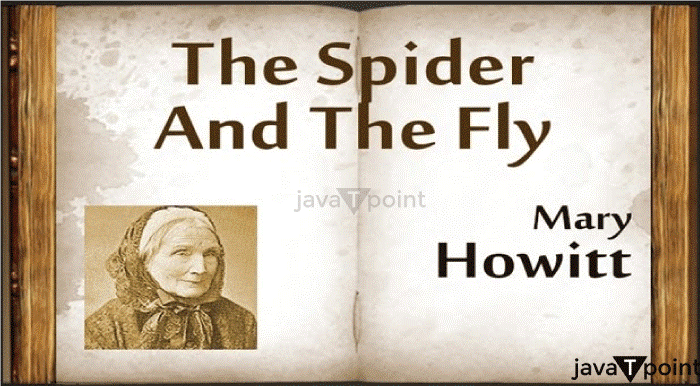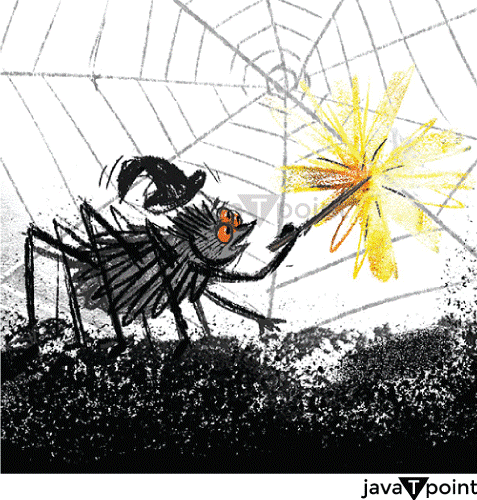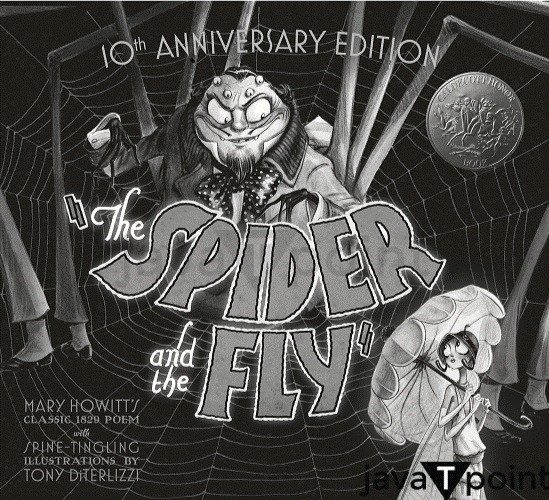The Spider and the Fly Summary"The Spider and the Fly" is considered one of Mary Howitt's magnificent works. It is a warning narrative about flattery. The Spider and the Fly is a dialogue between the Spider and the Fly. The Spider has been described as a predator and the Fly as prey. 
Summary of the PoemIt can be seen in the first stanza that Spider is tempting the Fly to visit his parlor. The Spider is trying to tempt the Fly with many pretty things so that the Fly can visit the parlor. The Spider describes his home as a mysterious place to trick the Fly so that he can captivate the Fly in his web. The Fly completely understands that when someone goes into the web has never come out. In the second stanza, the spide uses another trick to fool the Fly so that he can come to his home. He tries to show false sympathy for the Fly, that he must be exhausted, and offer his little bed for him to rest. He tries to entice the Fly by giving the false sense of protection by saying there are "pretty curtains drawn around." He gives his best to win the heart of the Fly by lending his shoulder to his rest. The Spider cunningly tries to establish a link between him and the Fly so that he can attack his prey easily. But the Fly is assured that she sleeps in the Spider web. The sleep will be forever for his life. She turned down the Spider's request and claimed that whoever had been to his bed for the sleep had never woken up. The constant usage of the word never symbolizes the distrust between the Spider and the Fly. In stanza 3, The Spider befriends the Fly by referring to her as a "Dear Friend." He wants to establish a fake bond of friendship and endearment. So that he can bring it to his home, he makes another attempt to lure him by the enticement of good food from the pantry. But on the other side, the Spider is fully determined to get lured by these false enticements. She smartly countered his move by saying, "Kind sir," rejecting his offer and telling him she was uninterested in them. 
In the 4th stanza, the Spider makes another attempt. This time he chose flattering to win her heart. The Spider referred to him as a "sweet creature." The move made by the Spider seems to be witty and wise. He repeatedly compliments her for her smartness and appearance. Some of the flattery lines used by the Spider are: "How handsome are your gauzy wings, how brilliant are your eyes!". He flirted with the Fly by appreciating his beauty and wanted to show his gorgeous face by showing him into the glass. It should be noted until this time, the Spider was limited to "Will you walk into my parlor? Will you rest upon my little bed? Will you please take a slice?". But for the first time, he suggested Fly that he has looking glass in his parlor upon his parlor shelf. These flatter lines seem to have worked on the Fly for the first. It appears that she was affected by these lines. This could be observed in the Fly response, where she moved his tone from being firm to gentle by saying, "O no, no!" to a soft "I thank you, gentle sir." This provides enough hints for the reader about what could be the fate of the Fly. Two possibilities can be noted here: The Fly has been completely influenced by the flatter, or she has stopped the Spider by conveying that she will return. In the 5th stanza, the Spider goes into his den. The application of the term "den" is of significant importance. Usually, the Spider is described with a web. But the usage of words is trying to give some amount of authority to the Spider. This automatically projects a spider as a strong and superior creature above the Fly. The Spider was assured that the Fly had fallen into his flattery lines and would soon enter his trap. The Spider weaved a little web into the corner to trap the Fly. He meticulously readied the dining table and waited for the Fly. He called him from witty and wise to silly after being fully confident she had fallen into the trap. The Spider excitedly visits the door and calls by saying Come hither, pretty fly, with the pearl and silver wing". He again uses flattery words like "pearl and silver wing" for the Fly. He tries to entice her by claiming that her eyes are beautiful and bright, like diamonds, and her green and purple robes. He increases the level of flirting by claiming that his eyes are like him. He continues with flatter shining diamonds; his eyes are dull like lead. He downgraded his personality for him and stressed her beauty with more robustness so that flattery could fully impact her. 
In Stanza 6, the Spider's confidence seems to have grown impressively. The strategy of conceit has worked for him. He ultimately betrays the Fly and gives in to his wicked cravings. The Fly is fascinated by the flattery lines of the Spider and decides to go too slowly to the spider web. The Fly immersed in her gorgeousness and contemplated his beautiful eyes and crested head. The Spider jumped on her and strongly grabbed her using this favorable period. The Spider instantly dragged her to the winding stair, his den, and later to his parlor. The Fly thought seems to have vindicated his thought, and she will never come out from the horrific den. In the seventh stanza, the speaker must have observed an instant change in the tone and tenor of the poem. The speaker conveys the message to the little ones reading the poem. The poet suggests and polite warning to fall prey to idle, silly, and flattering words. About the Author: Marry HowittMary Howitt was an English poet and author of the famous poem The Spider and the Fly. She was born on 12 March 1799 and departed on 30 January 1888. She was born at Coleford and married William Howitt in 1821. She settled at Hanley and did business as a chemist. 2 years later, they shifted to Nottingham and lived there for 12 years. Most of the literary works were carried out in Nottingham. They have also spent their night at Esher, London, Heidelberg, and Rome. They have produced a voluminous amount of literary work and have covered other subjects like economics, history, fiction, translations, and Social sciences. She translated Swedish Novels by Frederica Bermer and HC Andersen's Improvisatore and produced novels such as The Cost of Caergwyn and Wood Leighton, History of the United States. She has also produced some terrific poems and tales for little kids. She was also involved in joint productions such as Book of the Seasons, Ruined Abbeys and Castles of Great Britain, and The Forest Minstrel. Family and EducationHer father was Samuel Botham, a prosperous Quaker of Uttoxeter, and her mother's was Annie Wood. Mary Botham received her education at his home. She read various subjects and started to write on several subjects at an early age. She tied the knot with Uttoxeter William Witt on 16 April 1821 and started with collaborative writing with his husband. His literary production with his husband remained poetical and other contributions to periodicals and annuals. Their works were published in 1827 under the heading "The Desolation of Eyam," along with some poems were also published. Mary Howitt separated herself from her husband during her Australian journey. When she shifted to Esher in 1837, she began producing some popular stories for the children, and her long storybook received unprecedented success. While staying at Heidelberg in 1840, she studied Scandinavian literature. With his friend, Madame Schoultz, she began to learn Danish and Swedish. After that, she translated the novels of Fredrika Bremer, and she was the first to make them known to the English reader. She has also translated tales of Hans Andersons, such asThe Improvisatore 1845, Only a Fidler 1845, Wonderful Stories for Children 1846, and The True Story of Every Life 1847. She has edited Drawing-room Scrap Book; some original works were The Heir of West Wayian. Mary Howitt Notable Works
Next TopicThe Sun Rising Summary
|
 For Videos Join Our Youtube Channel: Join Now
For Videos Join Our Youtube Channel: Join Now
Feedback
- Send your Feedback to [email protected]
Help Others, Please Share









